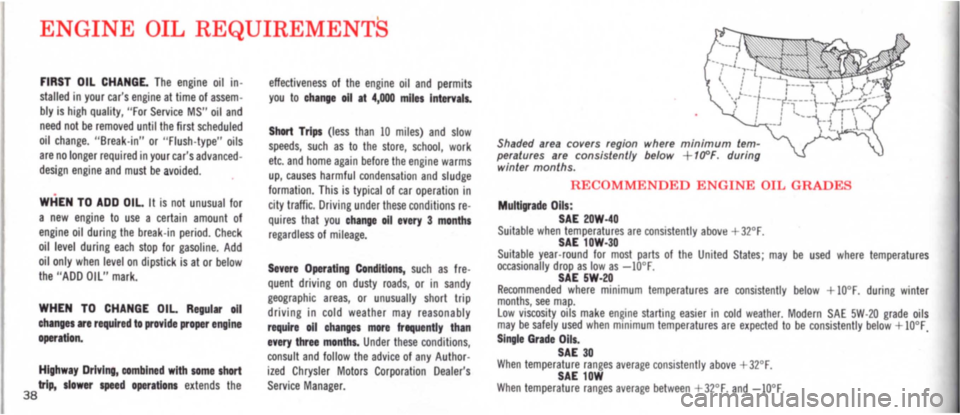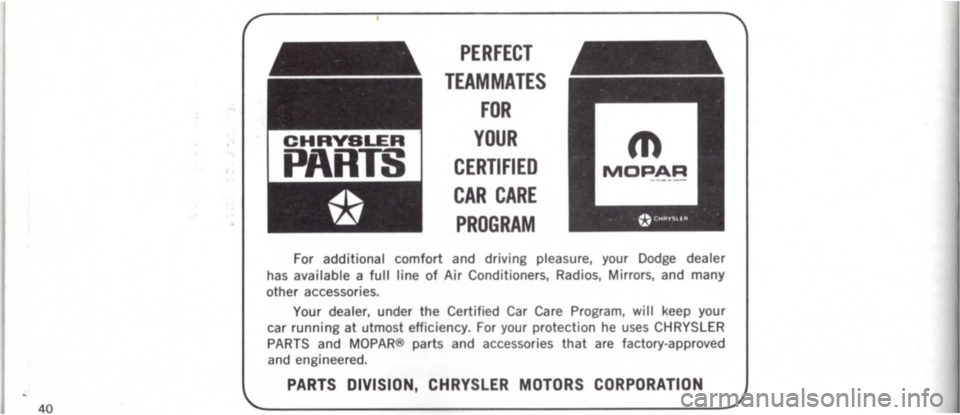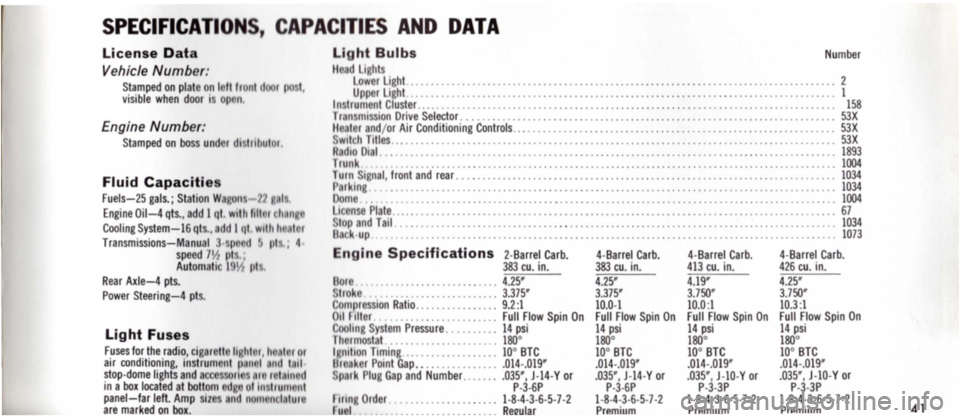1965 DODGE MONACO engine
[x] Cancel search: enginePage 40 of 46

(CONTINUlU)
CAUTION: To prevent possible wiring damage, certain precautions should be observed: It IS essential when replacing the cables on the battery, or when uSing a "booster" battery, thai the positive cable IS attached to the positive post and the negative cable IS attached to Ihe negative post. The negative cable IS attached to the engine block. Battery posts are marked plus (+ ) and minus (-). Also, If a "fast charger" is used while battery IS in car, disconnect both car battery cables before connecting the charger to battery. Do not use a "fast charger" to provide starting voltage.
which requires the following service attention. Two types are used -one has a wrapper on the carburetor air cleaner, and other does not. With Wrapper: Do the following every 6 months-inspect venhlator valve operation, clean filler cap, InSpect and clean air cleaner element and wash outer wrapper In kerosene and shake or blot dry. Every year-replace ventilator valve. Every two years-replace air cleaner element and wrapper. Without Wrapper: Do the follOWing at each change of engine Oil-inspect ventilator valve operation, Inspect and clean air cleaner element. Every year-replace ventilator valve and replace air cleaner element. More frequent servicing Crankcase Ventilation System. The engine in may be required if the car IS used for short. your car was equipped at the factory with a trip driving and prolonged engine idling. posItive ventilating system to reduce the emission of harmful fumes into the at mos· Ant/·Freele. So that your cooling system Will phere. Periodic and proper inspection and operate without freezing and Without over· cleaning of thiS valve is essential for good heating due to rust formation, the following engine performance and durability. Valve procedures should be observed. operation should be checked every 6 months O . . . by your Dealer, and more frequently if car IS Fall. Open ~adlator dralncock and remo~e used for short-trip driVing and prolonged threaded drain plugs In engine block to drain engine idling. Replace valve once a year. cooling system. Mov~ heat~r selector lever to ''HI'' or "Heat" position (If so eqUipped) to A special crankcase ventilation system is permit draining the heater lines. Thoroughly used on cars built for the state of California flush cooling system with clear water, then
36
close radiator draincock and replace engine block drain plugs. Install MoPar Anti·Freeze (or other high-quality equivalent) to assure cooling system protection for the lowest anticipated temperature in the area where vehicle IS operated dUring the winter months. The cooling system should contain a minimum of 400:, anll-freeze for proper corrosion protection. I n geographiC areas where anli· freeze protecllon IS not necessary, after flushing, fill with clear water and add MoPar Rust ReSistor (or other hlgh·quality co~rosion inhibitor) to prevent the formation of rust deposits. This service IS reqUired annually.
It the vehicle was placed into service after January I , 1965, the first required Fall cooling system service may be eliminated. With the approach of cool weather, however, it IS very important to test the coolant for adequate anti-freeze protection and InSpect the system for eVidence of rust or leaks.
Only glycols and synthetic alcohol (Methanol) are acceptable bases for automobile antifreeze. Solutions containing salts, sugar, honey, glucose, mineral oils, kerosene or similar material should never be used in the cooling system.
@Coolant Level: Have the coolant level checked during each stop at the gasoline station. Add water to bring level to about I-~' below the bottom of the filler neck. Overfilling Will dilute the anti-freeze and also result In coolant loss through the overflow tube. CAUTION: DriVing in heavy traffic, at high altitudes, or In very hot weather may build up pressure in the cooling system. When removing the cap place a cloth over the cap, turn left to first stop, allowing steam to escape through overflow tube, then remove cap.
Page 41 of 46

E) Coolant Level: Have the coolant level checked during each stop at the gasoline station. Add water to bring level to about 11,4' below the bottom of the filler neck. Overfilling will dilute the anti·freeze and also result in coolant loss through the overflow tube. CAUTION: Driving In heavy traffic, at high altitudes, or in very hot weather may build up pressure in the cooling system. When removing the cap place a cloth over the cap, turn left to first stop, allowing steam to escape through overflow tube, then remove cap.
Thermostat Your new car is equipped with 180 degree thermostat for use with perma· nenl-type anti-freeze. If you later prefer an lcohol type anti-freeze use only a 160 degree thormoslat.
Manifold Heal Control Valve_ A cold engine will warm up faster and accelerate more moothly if the valve that controls heat flow In the manifold works freely. It is normal for I d deposits to accumulate in time on the y lve shaft causing it to tighten up'. Manifold II t Control Valve Solvent, available from your dealer, should be applied a t six month lnt Iva Is. Slide shaft in and out and rotate a
, w times to distribute the solvent. Apply only when manifold is cool.
The Carburetor A ir Filter. The special easy to change fire-resistant filter installed in your carburetor should be cleaned and inspected every 6 months and replaced once every two years, to assure good fuel economy. Clean or replace more often when car is driven in dusty or sandy areas. Replace filter if damaged. DO NOT wash or oil. Simply remove the metal container, unscrew the wing nut and lift out filter. Clean with compressed air, holding nozzle about two inches from filter.
Fuel Filter. Your new car has a filter in the fuel tank to prevent water and foreign material from entering the fuel system. There is also a fuel filter in the fuel line at the fuel pump outlet. If this filter is plugged it can limit car speed and cause hard starling. Under normal operating conditions the filter should be changed at 20,000 mile intervals, or every two years.
011 Cap Filler. The cap on the oil filler tube is a combination ventilator and permanent filter. The filter inside the cap should be kept clean to allow clean air to remove combustion product s from the crankcase. To clean the filter wash the entire cap periodically in k ero sene and relubricate with SAE 30 engine oil.
ENGINE PERFORMANCE EVALUATION
Engine operation efficiency depends on correct ignition, carburetor adjustments, and on valve lash where applicable. To obtain best engine performance, Chrysler Corporation recommends that the engine be evaluated every 10,000 miles and tuned, if necessary. Services performed during this evaluation should include the following:
SPARK PLUGS-Remove and inspect each spark plug. Most plugs can be cleaned, adjusted, and reinstalled. Rough idle, hard starling, frequent engine miss at high speeds, or apparent physical deterioration, are indications that the spark plugs should be replaced.
DISTRIBUTOR-Clean and inspect the dis· tributor cap and rotor if required (wash cap in household detergent and water solution). Check breaker points for abnormal pitting. distributor secondary wires and tower caps are clean and connected properly. See that ignition timing is set to vehicle specifications.
CARBURETOR-Remove and clean air filter. Check operation of manifold heat control valve and choke diaphragms, use solvent recommended. Clean crankcase ventilator system. Check and adjust choke fast-idle cam and fuel mixture.
BATTERY-Check specific gravity. Clean and tighten terminals; apply grease to post and terminals. Check circuit voltages.
37
Page 42 of 46

ENGINE OIL REQUIREMENTS
FIRST OIL CHANGE. The engine oil installed in your car's engine at time of assembly is h igh quality, "For Service MS" oil and
need not be removed until the first scheduled
oil change_ "Break-in" or "Flush-type" oils are no longer required in you r car's advanced
design engine and m ust be avoided.
WHEN TO ADD OIL It is not unusual for
a new engine to use a certain amount of engine oil during the break-in period. Check
oil level during each stop for gasoline. Add oil only when level on dipstick is al or below
the "ADD OIL" mark.
WHEN TO CHANGE OIL Regul.,. 011 changes .,.e required to provide proper engine operation.
Highway Driving, combined with some short
trip, slower speed operations extends the 38
effectiveness of the engine oil and permits you to change 011 at 4,000 miles Intervals.
Short Trips (less than 10 miles) and slow speeds, such as to the store, school, work
etc. and home again before the engine warms up, causes harmful condensation and sludge formation. This is typical of car operation in
city traffic. Driving under these conditions re
quires that you change 011 every 3 months regardless of mileage.
Severe Operating Conditions, such as fre
quent driving on dusty roads, or in sandy geographic areas, or unusually short trip
driving in cold weather may reasonably require 011 changes more frequently than
every three months. Under these conditions, consult and follow the advice of any Authorized Chrysler Motors Corporation Dealer's
Service Manager.
Shaded area covers region where minimum temperatures are consistently below + 10"F. during
winter months.
RE MMENDED ENGINE OIL GRADE
Multigrade Oils: SAE 20W-40 Suitable when temperatures are co nsistently abovl! + 32°F. SAE 10W·30 Suitable year-round for most parts of the United States; may be used where temperatures occasionally drop as low as -10°F . SAE 5W·20 Recommended where minimu m temperatures are consistently below + 10°F . durin g winter months, see map. Low viscosity o ils make en~ine starting easier in cold weather. Modern SAE 5W-20 grade oils may be safely used when minimum temperatures are expected to be consistently below + 10°F. Single Grade Oils. SAE 30 When temperature ranges averag e co nsistently above 32°F . SAE lOW When temperature ranges average between + 32° F . and -10°F .
Page 44 of 46

I 40
PERFECT
TEAMMATES
FOR
CHRVSLER
PARTS
YOUR m
CERTIFIED
CAR CARE
PROGRAM
For additional comfort and driving pleasure, your Dodge dealer
has available a full line of Air Conditioners , Radios, Mirrors, and many
o t
her accessories.
Your deale r, under the Certified Car Care Program, will keep your
car running
at utmost efficiency. For your protection he uses CHRYSLER
P A
RTS and MOPAR parts and accessories that are factory-approved
and enginee re d .
PARTS DIVISION, CHRYSLER MOTORS CORPORATION
Page 45 of 46

SPECIFICATIONS, CAPACITIES AND DATA
License Data
Vehicle Number:
Stamped on plate on I It Ir nl d r I, visible when door IS op n .
Engine Number :
Stamped on boss und r d lIibulol
Fluid Capacities
Fuels-25 gals.; Station Wagoll
Engine Oil-4 qts., add 1 ql. with IiII r h 11M Cooling System-16 qts., dd 1 ql with hi ,II I
Transmissions-Manual 3 p d ~ III speed 7~ pi ., Automat I'M pi . Rear Axle-4 pts. Power Steering-4 pts.
Light Bulbs Number
It d Lights ower Light. ............................................................................... .. " 2 Upper Light .................................................................................... 1 In Irument Cluster ........................................................................ '" . . .. . . . 158 f r n smisslon Drive Selector. . . . . . .. .. .. . .. .. . .. . .. .. .. .. . . .. .. . .. .. . .. . .. .. • . .. . .. .. . .. .. . . .. . . . .... S3X II t r and/or Air Conditioning Controls. .. . . . . . . . . . . . . . . . . . . . . . .• . . . . . . . . . . . • . . . . . . . . . . . . . . . . . . . . . . . .. 53X SWitch Tilles ....................................................................................... 53X R dlo 01 I......................................................................................... 1893 flunk ....................................................................................... 1004 Turn Signal, front and rear ... ....................................................................... 1034 P rking .......................................................................................... 1034 Dom .................................. _ ...................................................... 1004 LI nS8 Plate. . . . . . . . . . . . . . . . . . . . . . . . . . . . . . . . . . . . . . . . . . . . . . . . . . . . . . . . . . . . . . . . . . . . . . . . . . . . . . . . . . . . . .. 67 lOP nd Tail .................................. ... ................................................. 1034 13 k up ...................................................... .................. ........... ..... 1073
Engine Specifications 2·Barrel Carbo 4·Barrel Carbo 4 -Barrel Carbo 4 ·Barrel Carbo 383 cu. in. 383 cu. in. 413 cu. in. 426 cu. in.
Bor ... ...................... 4.25' 4.25' 4.19' 4.25' trok .................... '" 3.375' 3.375' 3.150' 3.750' Compr ssion Ratio ................ 9.2:1 10.0· 1 10.0:1 10.3:1 II rllter ....................... . Full Flow Spin On Full Flow Spin On Full Flow Spin On Full Flow Spin On oohng System Pressure .......... 14 psi 14 psi 14 psi 14 psi rh rmostal...................... 1SO° lS00 1SO° 1SO°
I nllion Timing ................... 10° BTC 10" BTC 10° BTC 10° BTC BI k r POlOt Gap ................. 014·.019' .014·.019' .014,.019' .014·.019' p rk Plug Gap and Number ........ 035', J -14-Y or .035', J ·14-Y or .035', J -I0·Y or .035', J-lO·Y or P -3 ·6P P -3 ·6P P -3 ·3P P -3 ·3P rllmg Order .................... 1·8·4·3·6·5-7·2 1·8 ·4 -3 ·6 ·5 ·7 ·2 1·8 ·4 ·3 -6 ·5 ·7·2 1·8·4·3 ·6 ·5 ·7·2 IILl • ........................ Relwlar Premium Prl!millm Prl>mium 41